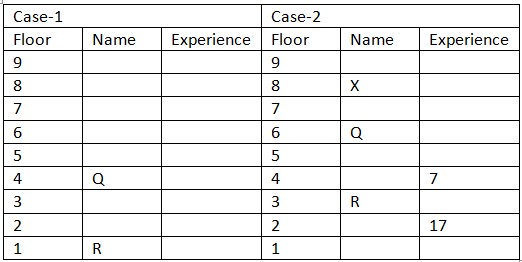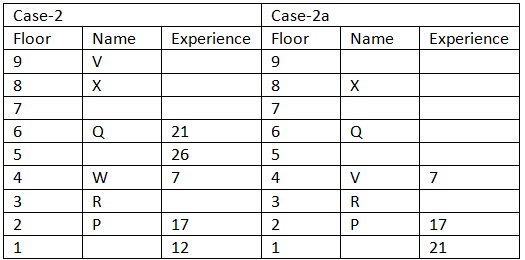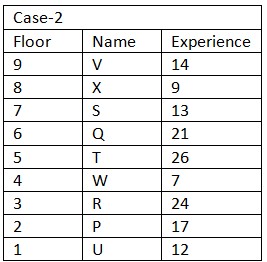Question
Who among the following lives on the eighth
floor? Study the following information carefully and answer the below questions. Nine persons namely – P, Q, R, S, T, U, V, W, and X live in a nine floored building marked 1 to 9 from bottom to top. Each person has different working experience viz.- 7, 9, 12, 13, 14, 17, 21, 24, and 26. All the information is not necessary in the same order. Note: The experience of the persons living on the adjacent floor is neither a common factor nor a common multiple. Q lives on an even number floor. R, who lives on any floor below floor number 4, lives three floors away from Q and doesn’t have experience of 12 years. W lives on any floor above the one whose experience is 12 years but not adjacent to Q’s floor. Neither Q nor R lives on the adjacent floor of X, who lives four floors away from the one whose experience is 7 years. V lives three floors above the one whose experience is 21 years. The number of persons living between Q and X is the same as the number of persons living below P, whose experience is 17 years. The number of persons living between V and the one whose experience is 26 years is one more than the number of persons living between the one whose experience is 12 years and W. Experience of X is neither 26 nor 14 years. The one whose experience is 14 years lives two floors away from S. The number of persons living between S and Q is the same as between S and the one whose experience is 9 years. W doesn’t live on the topmost floor. U has less experience than T.Solution
Q lives on an even number floor. R, who lives on any floor below floor number 4, lives three floors away from Q and doesn’t have experience of 12 years. That means, in case (2) Q lives on floor number 6, in case (1) Q lives on floor number 4. Neither Q nor R lives on the adjacent floor of X, who lives four floors away from the one whose experience is 7 years. The number of persons living between Q and X is the same as the number of persons living below P, whose experience is 17 years. That means, in case (2) X lives on floor number 8, case (1) is not valid. Based on the above given information we have:  Case (1) is not valid as the number of persons living between Q and X is the same as the number of persons living below P, whose experience is 17 years. Again, we have: V lives three floors above the one whose experience is 21 years. That means, in case (2) V lives on floor number 9, in case (2a) V lives on floor number 4. The number of persons living between V and the one whose experience is 26 years is one more than the number of persons living between the one whose experience is 12 years and W. The experience of X is neither 26 nor 14 years. W lives on any floor above the one whose experience is 12 years but not adjacent to Q’s floor. W doesn’t live on the topmost floor. That means, in case (2) the one whose experience is 12 years lives on floor number 1, case (2a) is not valid. Based on the above given information we have:
Case (1) is not valid as the number of persons living between Q and X is the same as the number of persons living below P, whose experience is 17 years. Again, we have: V lives three floors above the one whose experience is 21 years. That means, in case (2) V lives on floor number 9, in case (2a) V lives on floor number 4. The number of persons living between V and the one whose experience is 26 years is one more than the number of persons living between the one whose experience is 12 years and W. The experience of X is neither 26 nor 14 years. W lives on any floor above the one whose experience is 12 years but not adjacent to Q’s floor. W doesn’t live on the topmost floor. That means, in case (2) the one whose experience is 12 years lives on floor number 1, case (2a) is not valid. Based on the above given information we have:  Case (2a) is not valid as W lives on any floor above the one whose experience is 12 years but not adjacent to Q’s floor and W doesn’t live on the topmost floor. Again, we have: The one whose experience is 14 years lives two floors away from S. U has less experience than T. The number of persons living between S and Q is the same as between S and the one whose experience is 9 years. Since, persons whose experiences are in common multiple are not living on the adjacent floor. This, the experience of S is 13 years. Based on the above given information we have
Case (2a) is not valid as W lives on any floor above the one whose experience is 12 years but not adjacent to Q’s floor and W doesn’t live on the topmost floor. Again, we have: The one whose experience is 14 years lives two floors away from S. U has less experience than T. The number of persons living between S and Q is the same as between S and the one whose experience is 9 years. Since, persons whose experiences are in common multiple are not living on the adjacent floor. This, the experience of S is 13 years. Based on the above given information we have 
How is F related to C?
Answer the questions based on the information given below.
Nine persons F, G, H, I, J, K, L, M, and N belong to a family of two generations. No...
If Aman is the brother of Babita; Babita is the sister of Chetan and Chetan is the father of Deep, how Deep is related to Aman?
How is E related to H?
If father of V is brother of mother of W’s wife’s brother. How is sister of husband of mother of V related to W’s son’s mother’s brother’s ...
How is M related to O?
How is O related to mother of L?
Which among the following is/are the husband-wife pair?
...How many male members are there in the family?
- Ankita is sister of the son of Gautam. Deepak’s wife is mother of Suravi. Lata is grandmother of Suravi. There are two married couple in the family. How ...
Relevant for Exams:



